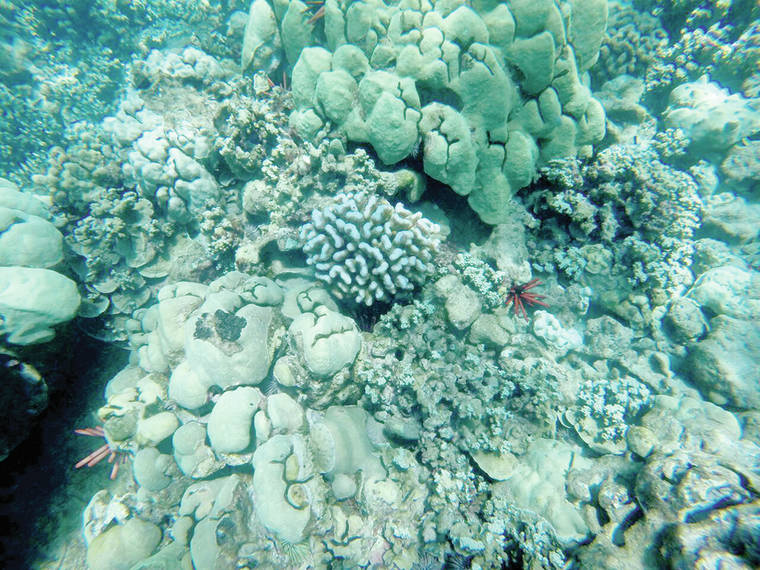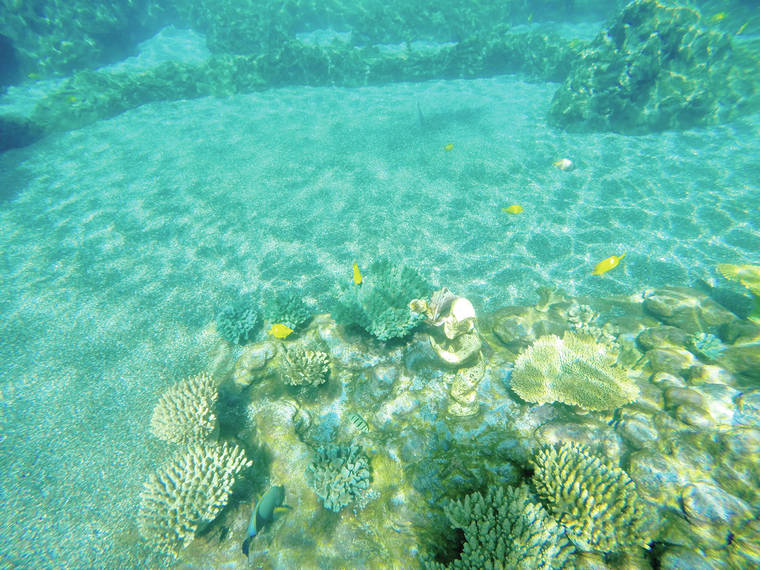Bleached corals found
LIHUE — Corals in Hawaii have started bleaching, according to the Department of Land and Natural Resources, and local reports show concern for some of Kauai’s corals as well.
National Oceanic and Atmospheric Administration predicted in early August that there would be a widespread and severe bleaching event in the coming months after tracking a “blob” of warm water moving toward the Pacific, akin to The Blob that triggered bleaching in 2015.
DLNR Division of Aquatic Resources (DAR) announced Wednesday results from a rapid assessment of coral health at Molokini along Maui’s south shore from Makena to Maalaea.
And they found bleached corals.
“Molokini is composed of high percentages of the coral species, Montipora capitata, and we found roughly 50% of this coral already bleached or paling heavily,” said Russell Sparks, DAR Aquatic Biologist in a Wednesday DLNR news release.
The team found in waters off Makena, Wailea, and Kihei the percentage of corals showing bleaching currently at less than 10%.
Sparks said that reefs in dirty water (closer to shore at Kalama Park and other areas in North Kihei) are doing better than in similar areas with cleaner water. This may be due to the shading effect of dirty water reducing some of the stress from direct sunlight on these corals, according to DLNR. At Olowalu, routine monitoring in August did detect numerous Porities corals bleached and overgrown with turf algae.
On Kauai, reports are trickling in of bleaching at Anini. Those reports point to thick algae growths, some corals starting to turn white and others potentially infected with black band disease.
Organizations like Eyes of the Reef have put the word out for citizens to do their part in monitoring reef health. EOR has a reporting mechanism specifically for coral disease — anyone can make a report online of any bleaching, diseased or abnormal coral they see.
In August, NOAA’s Coral Reef Watch upgraded alert levels from “watch” to “warning” status, and put the alert levels at the highest setting for mid-September through November in Hawaii waters.
Just before the August Coral Reef Watch announcement, NOAA announced the waters in the Pacific are cooling down and the El Nino was ending.
At the beginning of September, NOAA reported “a mass of anomalously warm water” has developed off the west coast of the United States and said that warm anomalies have been surrounding both the Northwestern Hawaiian Islands and the Main Hawaiian Islands for the last few months.
DLNR says those higher temperatures are mostly concentrated along West Hawaii and Maui Nui, saying they’re “especially warm.”
National Weather Service has also pointed out Hawaii’s high temperatures have been breaking records in the past few months.
Temperatures throughout the Hawaiian archipelago are expected to keep rising through October, according to NOAA.
NOAA, DAR and the Arizona State University Center for Global Discovery and Conservation Science have joined forces to collaborate on coral reef science, conservation, and management in Hawaii.
One of the outcomes of this partnership is the creation of a coral bleaching alert card, which depicts six, simple steps people can take to reduce any additional stress on corals during the current bleaching event.
Those steps are available online at www.hawaiicoral.org, which is meant to be a platform that “that integrates coral observations made by residents and visitors with observations made from the air and Earth orbit” according to Dr. Greg Asner, the Director of ASU-GDCS. You can also report to Eyes of the Reef at eorhawaii.org.
“The outcome is a real-time monitoring system that informs citizens as fast as scientists are getting data,” Asner said in Wednesday’s release. “Together, we can not only monitor this terrible bleaching event, but also work to reduce secondary stress on the most impacted reefs. After the heatwave ends, we will have a good map with which to plan restoration efforts.”
•••
Jessica Else, environment reporter, can be reached at 245-0452 or jelse@thegardenisland.com.



Well Hello, Terry Lilly of Kauai has been telling us this and showing us his pictures for like 10 years now! As usual DNLR is a day late and dollar short. Not good stewards of Hawaii!!